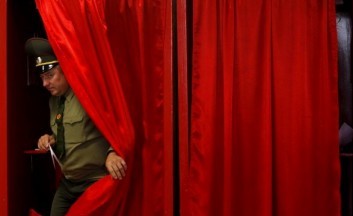Election campaign results: the elections took place, a boycott did not
 The situation has not changed
The situation has not changed

The elections’ main political outcome was that they demonstrated the sustainability and effectiveness of the power vertical. Belarusian authorities have proved that they can manage the campaign’s progress effectively and achieve the desired voter turnout, but the price they have to pay for the lack of competition in the electoral process is the population’s political apathy and growing lack of confidence in the authorities. The opposition, which had not set any political goals during the campaign, started shaping two new internal coalitions.
All the major participants in the election campaign remain at where they started off. The authorities have a predictable and controllable Parliament. The opposition can focus on its internal problems and continue building coalitions. In particular, on September 23rd, before the voting ended five opposition movements – BNF, the Belarusian Social Democratic Party “Hramada”, Belarusian Left Party “Fair World”, “For Freedom” and “Tell the Truth!” – issued a joint statement about non-recognition of the elections results. Earlier, six other organizations also issued a joint statement (see ‘Opposition’s post elections coalitions shaping up’).
The campaign has demonstrated that today the authorities have the greatest influence on the electorate and can guarantee 50% turnout, which is needed to validate the elections. Official data says the turnout at these elections was 74.2% with 26% early voting turnout. Note that 50% turnout threshold was achieved in all constituencies by 18:00 on September 23rd. Official data differs from independent monitoring data by 10-15%, which can be explained by artificially increased turnout.
The authorities had a clear strategy and tactics to mobilize voters. ‘Controlled mobilization’ strategy aimed to “wake up” the society just enough to secure the desired turnout, but not enough for the opposition to use it for their political goals, for instance, to boycott the elections. The authorities used different tactics: election commissions were staffed with loyal members and there were loyal elections observers, there were targeted information campaigns and repressions against opposition activists, including use of various pressure tools on voters (encouraging and repressive) to step up to the vote, for instance, ballot box stuffing, which was reported by an independent observer in the Mogilev constituency no. 87.
The precinct and district election commissions and observers groups have been largely formed by members in the pro-state associations and parties, such as the Federation of Trade Unions of Belarus, “Belaya Rus”, the Belarusian Republican Youth Union, the Communist Party of Belarus, Belarusian Social Sports Party and others. The oppositions’ participation was minimal.
Early voting took place on September 18th – 22nd with a traditional turnout of 26% before the Election Day on September 23rd. On principal, Belarusians are willing to vote early, during this campaign, 1 825 062 people used their right to vote early. Nevertheless, the authorities used traditional tools to achieve the desired results: providing additional days off for those who voted early and exerting pressure on social groups particularly dependent on the state: students, soldiers, teachers, etc.
All the mentioned above measures allowed the authorities to succeed in achieving the campaign’s key strategic objective and to keep the election’s heat at a safe and adequate range. One should anticipate that there will be a traditional continuity between the new and the old Parliament, namely, it will remain a controlled tool to coordinate public policies, developed the President’s Administration and the Council of Ministers.
Subscribe to our newsletter




Situation in Belarus
Constitutional referendum: main consequences


 Video
Video
How to count the political prisoners: are the new criteria needed?


 Video
Video
Paternalism In Decline, Belarusian Euroscepticism, And The Influence Of Russia


 Video
Video












